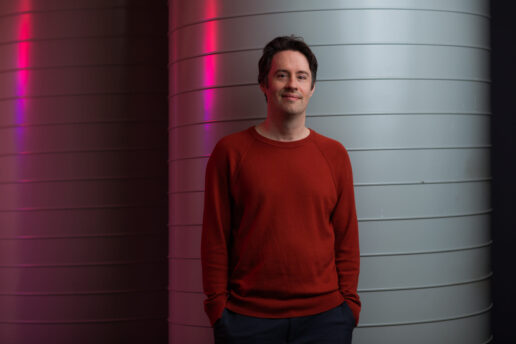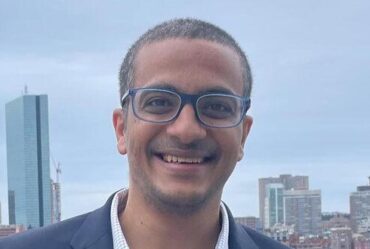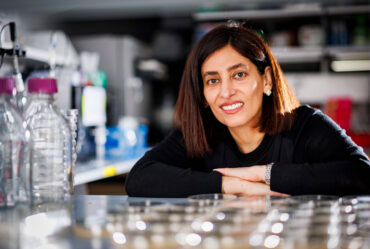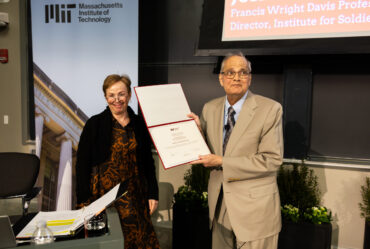
Life in a hologram
Physicist Daniel Harlow explores an alternate quantum reality in search of fundamental truths to our physical universe.
Dan Harlow spends a lot of time thinking in a “boomerang” universe.
The MIT physicist is searching for answers to one of the biggest questions in modern physics: How can our universe abide by two incompatible rulebooks?
The first — the Standard Model of Physics — is the quantum mechanical theory of particles, fields, and forces, and the ways in which they interact to build the universe we live in. The second — Einstein’s theory of general relativity — describes the influence of gravity and how the fundamental force pulls together matter to build the planets, galaxies, and other massive objects.
Both theories do remarkably well in their respective lanes. However, Einstein’s theory breaks down when trying to describe how gravity works at quantum scales, while quantum mechanics makes reality-bending predictions when applied at massive, cosmic dimensions. For over a century, physicists have searched for ways to unite the two theories and get to the truth of what makes our universe tick.
Harlow suspects that any connecting thread may be too delicate to grasp in our existing universe. Instead, he’s looking for answers in a “boomerang” version — an alternate reality that folds back on itself, much like a boomerang’s trajectory, rather than stretching and expanding without end as our actual universe does. Quantum gravity in this boomerang universe turns out to be easier to understand, as it can be reformulated in terms of conventional quantum theory (without gravity) using a powerful idea called holographic duality. This makes it far simpler to contemplate, at least from a theory perspective.
In this boomerang environment, Harlow has made some exciting, unexpected revelations. He has shown, for instance, that the equations that describe how gravity behaves in this “toy” universe are the very same equations that control the quantum error-correcting codes that will hopefully soon be used to build real-world quantum computers. That the mathematics describing gravity should have anything to do with protecting information in quantum computers was a surprise in itself. The fact that both phenomena shared the same physics, at least in this alternate universe, suggests a potential connection between Einstein’s theory and quantum mechanics in the real universe.
The discovery, which Harlow made as a postdoc at Princeton University in 2014, sparked fresh lines of inquiry in the study of both quantum gravity and quantum information theory. Since joining MIT and the Center for Theoretical Physics in 2017, Harlow has continued his search for fundamental connections between general relativity and quantum mechanics, and how they may intersect in the contexts of black holes and cosmology.
“One of the things that’s been fun is, even though in physics and more in generally science we’re all studying different systems and experiments, many of the ideas are the same,” says Harlow, an associate professor who received tenure in 2022. “So, I try to have an open mind and keep my ears open, and look for how things may be related.”
“A humanist philosophy”
Born in Cincinnati, Harlow moved as a child with his family to Boston, where he spent several years before the family moved again, putting down roots in Chicago. When he was 10, he took up piano lessons, focusing first on classical music, then rock. In junior high, he played keyboard in various bands before finding his groove in the looser, more improvisational style of jazz.
“I love sitting down and playing with people, and seeing where things will go,” Harlow says.
His love of jazz was partly what drew him to New York City after high school, where he attended Columbia University, which happened to be near some of the best jazz clubs in the city. The university’s core curriculum, which required students to read classic works of literature and philosophy, also appealed.
“You can’t graduate from Columbia without reading “The Iliad,” Harlow says. “That gives you a shared community of things you can talk about. I liked the humanist philosophy that drives the place. Even if I chose to be a physicist, I would still have this broader cultural experience.”
Harlow worked for three years as an undergraduate research assistant in an experimental cosmology lab on campus, where he learned to work in a clean room and run simulations to improve the performance of filters that were designed to pick out subtle signs of radiation left over from the Big Bang.
Harlow particularly appreciated the general approach of the lab’s leader, Amber Miller, who was then a junior faculty member.
“She had this great way she ran her group, where she wasn’t so hung up on publications or getting things done on a short timescale,” Harlow recalls. “She just let us play around.”
Open questions
That mental freedom to explore new ideas would stay with Harlow throughout his career. From Columbia, he went west to Stanford University in 2006. Within the physics department, he found he aligned most naturally with Professor Leonard Susskind, a theoretical physicist and leader in the study of string theory.
“His strong desire to identify the things that aren’t important and set them aside so you can focus on the essence of the problem — that was also the way I try to think,” says Harlow, who ended up choosing Susskind as his advisor. “Lenny said, ‘work on whatever you want, and I’ll talk to you about it.’”
With this open invitation, Harlow kept an ear on conversations within Susskind’s group to get a sense of the big questions in the field. What he heard was a problem that would shape the rest of his research career: the question of how to connect quantum mechanics with general relativity, in the context of cosmology, and scientists’ understanding of the large-scale structure and evolution of the universe.
In search of an answer, Harlow read up on everything he could find on both theories. His reading also bled into quantum information science — primarily, a field that focuses on applying principles of quantum mechanics and information theory to the study and development of quantum computers.
“Whenever I have a hint that some tool will be important for a problem I’m trying to solve, I learn much more about it than what I think I need,” Harlow says. “More often than not, that investment pays off.”
At the end of his time at Stanford, Harlow decided to “take a hard turn,” pivoting from cosmology to black holes, which he considered to be a simpler system to study for any fundamental threads connecting quantum mechanics and general relativity.
In 2012, he went back east to Princeton for a three-year postdoc, during which he began to explore the quantum behavior of gravitational black holes. To simplify the problem, he did so in a “boomerang” universe — what physicists know as “anti-de Sitter space,” named after the physicist who studied the curvature of the universe. As Harlow read more on quantum information, he noticed, and ultimately confirmed, an unexpected overlap in the physics of gravity around black holes and the quantum error-correcting codes designed to protect information.
“That was a very exploratory, transformative time,” Harlow says. “I’m still exploring a lot of the paths that I started there.”
After a second postdoc at Harvard University, Harlow joined MIT as a junior faculty member in 2017, where he continues to make surprising connections in the study of quantum gravity and quantum information science. At the Institute, and in the field of theoretical physics more broadly, he’s enjoyed a collegial, productive disregard for authority.
“This is a community where I can go up to the most famous theoretical physicist in the world, tell them that they’re wrong, and if I have an argument, they’ll listen to me,” Harlow says. “People are open. There’s this core shared agreement that, what matters is that we find the right answer. It matters less who finds it.”
Among Harlow’s accomplishments since coming to MIT are a proof that there are strong restrictions on the possible symmetries of quantum gravity, a deeper understanding of the nature of energy in gravitational systems, and a concrete mathematical framework for understanding the interiors of quantum mechanical black holes.
Beyond research, Harlow is working to bring more diverse voices and perspectives into the field of physics. In addition to mentoring and advocacy work outside of MIT, he is running a program within the physics department that invites students from underrepresented and underprivileged backgrounds to carry out physics research at MIT each summer.
“Unfortunately physics remains rather white and male, and making it more welcoming and accessible to a broader slice of humanity is one of my priorities going forward,” he says.
Looking ahead, Harlow is considering taking a new turn in his research path, perhaps to focus less on black holes in a hologram universe, and more on cosmology, and the quantum structure and evolution of our actual universe.
“I’ve been living in anti-de Sitter space for a long time,” Harlow says. “That’s fine, but I do want to understand the world we live in too. And that should be fun.”


